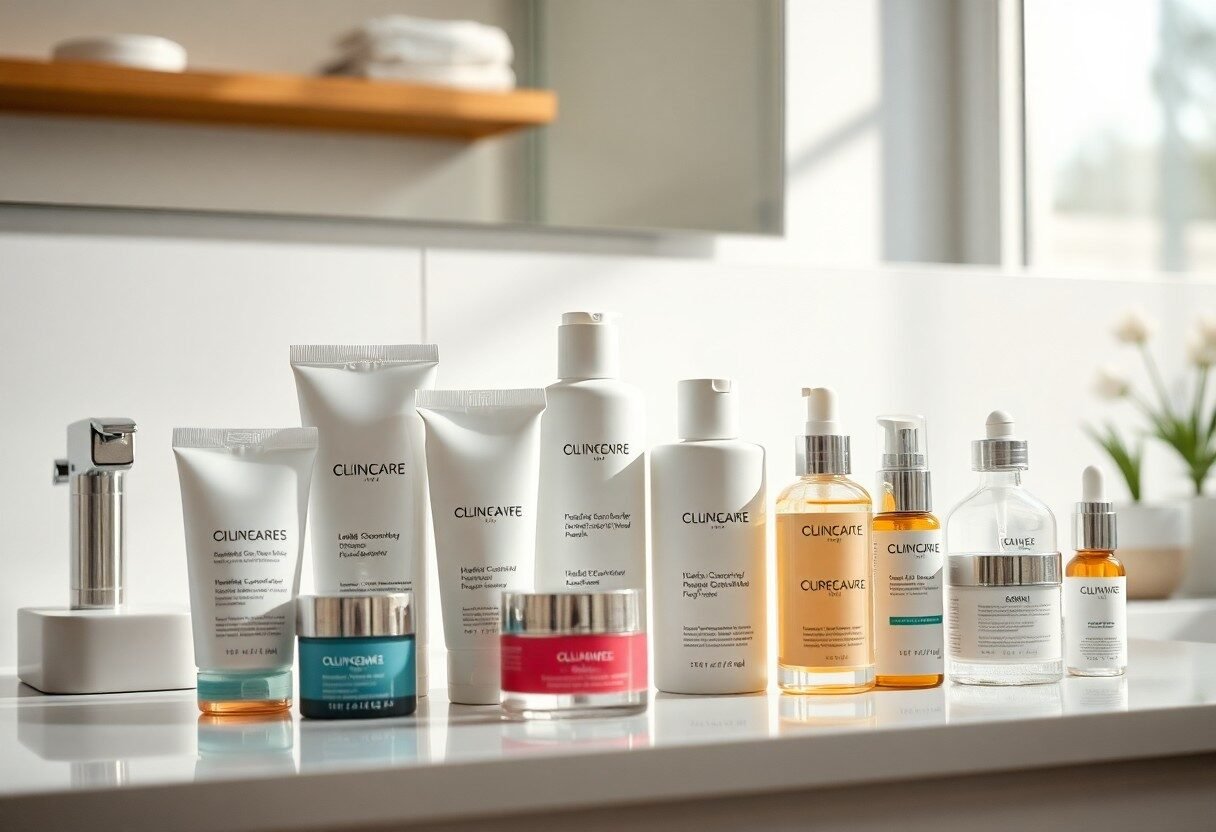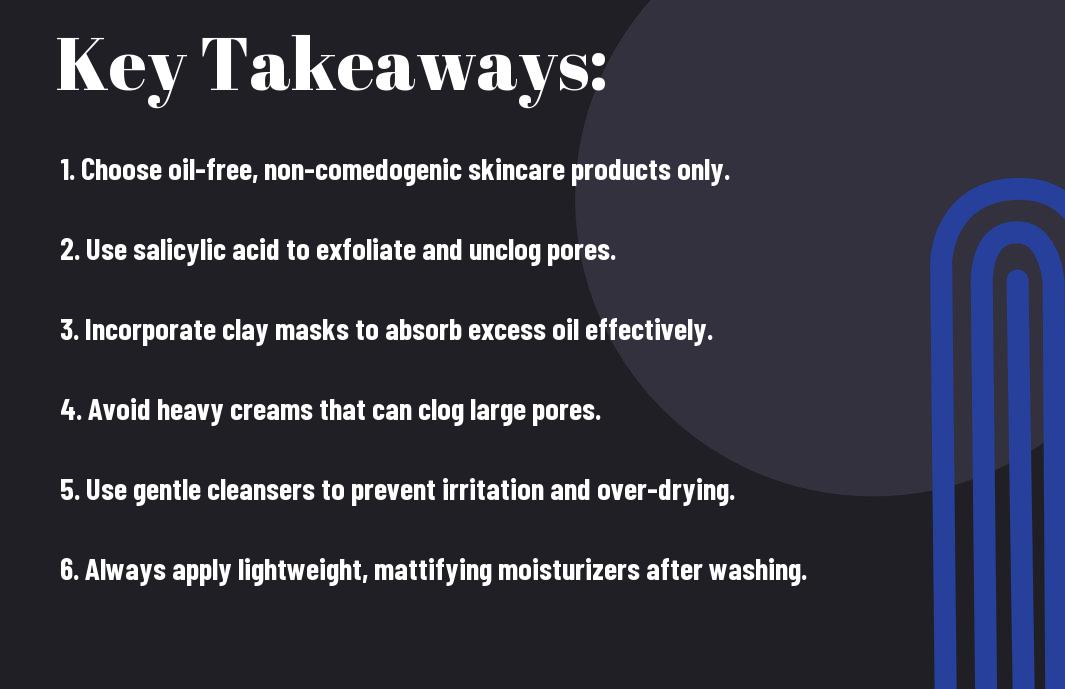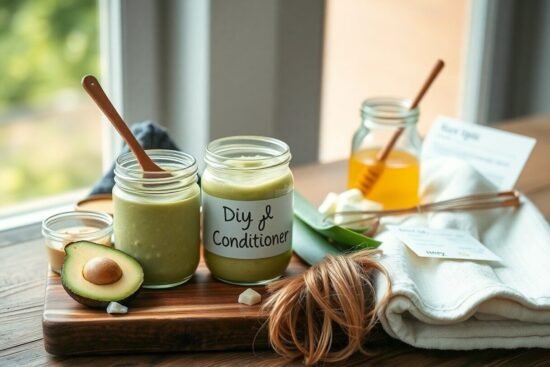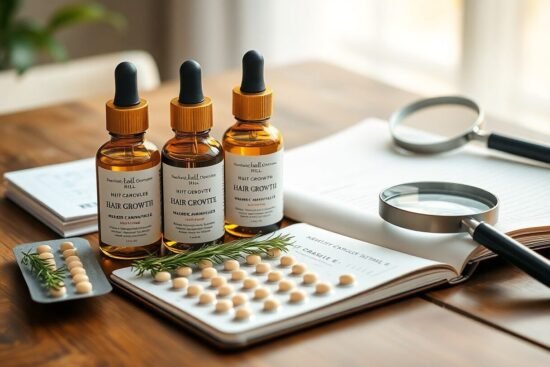
You may find it challenging to manage oily skin and large pores, but there are effective skincare products designed specifically for your needs. In my experience, incorporating the right cleansers, toners, and moisturizers can significantly improve your skin’s appearance. I will guide you through selecting products that not only control oil but also minimize the appearance of pores, leaving your skin looking smooth and healthy. Whether you’re battling shine or texture, the right choices can transform your skincare routine.
Key Takeaways:
- Look for products labeled as non-comedogenic, which are less likely to clog pores.
- Opt for lightweight, oil-free moisturizers to hydrate the skin without adding excess oil.
- Consider using salicylic acid or glycolic acid exfoliants to help reduce the appearance of large pores.
- Use mattifying primers and foundations designed for oily skin to control shine throughout the day.
- Incorporate clay masks into your weekly routine to help absorb excess oil and impurities.
- Choose products enriched with niacinamide, which can help minimize pores and regulate oil production.
- Be cautious with heavy creams and oils, opting instead for gel-based alternatives that provide hydration without greasiness.

Unmasking Oily Skin: Causes and Implications
Understanding the root causes behind oily skin helps in choosing the right skincare products. Factors such as genetics, hormones, and environmental influences play significant roles in the production of excess oil. This can lead to enlarged pores, a shiny complexion, and an unfortunate tendency toward acne and breakouts. By addressing these underlying issues, you can better manage oily skin and promote a healthier appearance.
The Role of Genetics and Hormones
Genetics significantly influences the type and amount of oil your skin produces. If your parents had oily skin, chances are you may experience the same. Hormones also play a pivotal role; during puberty, menstrual cycles, or due to conditions such as polycystic ovary syndrome (PCOS), hormonal fluctuations can lead to increased oil production. Understanding these factors can help you select specific products targeted for your skin type.
Environmental Factors Influencing Oil Production
Environmental factors such as humidity, air pollution, and climate can greatly affect oil production. High humidity stimulates your sebaceous glands, resulting in increased oil secretion. Air pollutants can clog pores and contribute to acne, aggravating oily skin conditions. In high-stress situations, adrenal hormones may intensify oil production as well. Understanding these variables allows you to adapt your skincare routine accordingly.
- Humidity can boost oil secretion.
- Air pollution clogs pores and exacerbates breakouts.
- Climate conditions impact oil levels.
- Stress can trigger hormonal changes that increase oil production.
- Any adjustments to your routine should consider these environmental influences.
Incorporating products that combat the effects of environmental factors is important for managing oily skin. For example, using clay masks can help absorb excess oil during humid months. Additionally, ingredients like salicylic acid can penetrate and cleanse clogged pores, making it a formidable choice for oily skin types living in polluted areas. Exploring these options can lead to a more balanced complexion.
- Clay masks absorb excess oil effectively.
- Salicylic acid helps remove impurities from pores.
- Products containing antioxidants enhance skin health.
- Hydrating toners can balance oil levels.
- Any proactive approach will improve your skin’s overall appearance.
The Pore Dilemma: Understanding Large Pores
Large pores can be a frustrating aspect of oily skin, often leading to an uneven texture and acne breakouts. Their visibility can stem from various factors including genetics, age, and skin health, making it imperative to understand their structure and underlying causes. By addressing pore concerns effectively, I can create a clearer, more refined complexion and enhance the overall health of my skin.
Anatomy of Pores and Their Function
Pores are tiny openings in the skin that serve as pathways for hair follicles and oil glands. Each pore contains sebaceous glands that produce sebum, which acts as a natural moisturizer, helping to keep the skin hydrated and maintain its barrier function. Despite their small size, pores can significantly influence the overall appearance and health of my skin.
What Causes Pore Enlargement?
Pore enlargement often results from a combination of factors such as increased sebum production, accumulation of dead skin cells, and loss of skin elasticity. As I age, the natural reduction in collagen and elastin can lead to the stretching of pores, making them appear larger. Additionally, environmental factors like sun exposure and pollution can contribute to their visibility.
The primary concern regarding pore enlargement revolves around oiliness and clogged pores. Overactive sebaceous glands produce more oil, which, when combined with dead skin cells, can block the openings. This blockage stretches the pores, making them appear prominent. Factors like hormonal fluctuations during puberty or menstruation can also exacerbate this issue, leading to spikes in oil production. Addressing these root causes with the right skincare products—such as salicylic acid cleansers or oil-free moisturizers—can mitigate pore enlargement while keeping your oily skin balanced.

Targeted Ingredients for Oily Skin
Choosing skincare products with targeted ingredients can dramatically improve the condition of oily skin and minimize the appearance of large pores. Ingredients like salicylic acid, niacinamide, and retinol can help regulate oil production, combat acne, and refine skin texture. By focusing on these effective components, you can tailor your skincare routine to address the specific needs of your oily skin, leading to clearer, healthier skin over time.
The Power of Salicylic Acid and Benzoyl Peroxide
Salicylic acid penetrates deep into pores, extracting excess oil and dead skin cells, making it a powerful ally for oily skin. Benzoyl peroxide works to kill acne-causing bacteria, reducing breakouts and inflammation. Using products with these ingredients can clear up your complexion and keep pores from becoming clogged.
The Benefits of Niacinamide and Retinol
Niacinamide offers a multitude of benefits for oily skin, including reducing sebum production and minimizing pore size. It also possesses anti-inflammatory properties, making it effective in calming redness and irritation. Retinol, a vitamin A derivative, promotes cell turnover and unveils smoother skin. It helps to regulate oiliness while also targeting fine lines, resulting in a youthful appearance.
Niacinamide not only helps in controlling excess oil but also strengthens the skin barrier, leading to fewer breakouts over time. Studies indicate that it can reduce pore visibility by improving skin elasticity and texture. Incorporating retinol in your routine boosts cell renewal, effectively diminishing the appearance of large pores and preventing acne blemishes. Together, these ingredients can transform your skincare regimen, offering both corrective and preventive benefits for oily skin.
Product Categories to Consider
Focusing on specific product categories will streamline your search for effective skincare. Prioritize cleansers that balance and clarify, targeted moisturizers tailored for oily skin, as well as specialized treatments designed to minimize pore appearance. Incorporating exfoliants and clay masks into your routine can also enhance results, helping you achieve a smoother texture while keeping oil production in check.
Cleansers that Balance and Clarify
Cleansers play a critical role in managing oily skin. Look for gel-based formulas that contain ingredients like salicylic acid or tea tree oil, known for their ability to thoroughly remove excess oil without stripping the skin. I prefer cleansers that are sulfate-free to avoid irritation while still effectively balancing my complexion. A good option might be a foaming cleanser that not only removes impurities but also helps to control shine throughout the day.
Moisturizers Designed for Oily Skin
For oily skin, selecting the right moisturizer is imperative. Lightweight, oil-free formulas with hydrating ingredients such as hyaluronic acid or glycerin can keep your skin hydrated without clogging pores. Non-comedogenic moisturizers often contain mattifying agents to control shine, making them an ideal choice. You may find gel moisturizers particularly effective, as they absorb quickly and provide hydration without a greasy feel.
In my experience, brands like Neutrogena and La Roche-Posay offer great options with targeted formulations for oily skin. Their gel moisturizers often harness ingredients like niacinamide, which is known to regulate sebum production while improving skin texture. It’s worth exploring products that include SPF protections for daytime use to ensure your skin is safeguarded from environmental factors while maintaining that much-needed hydration.
Essential Application Tips for Maximum Impact
To achieve the best results with your skincare routine, focus on proper application techniques. Start by cleansing your face with a gentle cleanser that won’t strip your skin of its natural oils. After cleansing, apply products in thin layers; this not only helps your skin absorb them better but also reduces the risk of clogged pores. Furthermore, avoid aggressive scrubbing. Instead, opt for a light patting motion to apply serums and moisturizers. Investing in your technique can maximize the effectiveness of your skincare regimen. Perceiving the difference in your skin can be quite rewarding.
Layering Products: Order Matters
The order in which you apply your products can significantly impact their effectiveness. Begin with the lightweight serums or toners, followed by heavier moisturizers and treatments. This layering method allows the lighter formulas to penetrate deeply, enabling the thicker products to lock in hydration. For those with oily skin, be mindful not to over-layer; sticking to a few crucial products can help keep your skin balanced without adding extra oil.
Timing Your Skincare Routine for Optimal Results
Adhering to a consistent timing schedule for your skincare routine enhances effectiveness. Applying your products at the right times lets them work synergistically with your skin’s natural rhythms. For instance, utilizing serums with active ingredients at night when your skin is in repair mode can yield better results. Patch testing and finding your skin’s response to specific ingredients is also advisable, especially when using exfoliants or acids.
The evening is typically the best time for applying potent ingredients because your skin goes through a natural repair cycle overnight. By introducing treatments like retinol or BHAs in the evening, you allow them ample time to work without the interference of sun exposure. Start by establishing a consistent routine each night. This maintains and enhances your skin’s health over time. Checking back and adjusting your routine based on how your skin responds is beneficial for achieving the best results possible.
To wrap up
Hence, selecting the right skincare products for women with oily skin and large pores is crucial for achieving a healthy complexion. I recommend you focus on lightweight, non-comedogenic formulas that control excess oil while minimizing the appearance of pores. Incorporate exfoliants to keep your skin smooth and toners to balance oil production. Additionally, always prioritize hydration with oil-free moisturizers. By adopting these products into your skincare routine, you’ll be able to manage your oily skin effectively and enhance your confidence in your natural beauty.
FAQ
Q: What types of ingredients should women with oily skin look for in skincare products?
A: Women with oily skin should look for products that contain ingredients such as salicylic acid, glycolic acid, niacinamide, and tea tree oil. These ingredients help control excess oil production, exfoliate dead skin cells, and minimize the appearance of pores. Additionally, lightweight moisturizers and oil-free options are ideal to keep the skin hydrated without adding extra oil.
Q: Are there specific types of cleansers recommended for oily skin?
A: Yes, gel-based or foaming cleansers are generally recommended for oily skin. These types of cleansers often contain surfactants that effectively remove excess oil and impurities. Look for products that are labeled as non-comedogenic to ensure they won’t clog the pores. Cleansers with exfoliating properties can also be beneficial in managing oily skin and large pores.
Q: Should I use exfoliators if I have oily skin?
A: Exfoliation can be beneficial for oily skin to help clear clogged pores and remove dead skin cells. However, it is important to choose the right type of exfoliant; chemical exfoliants, such as AHAs and BHAs, are typically recommended. It’s advisable to exfoliate 2-3 times a week to avoid irritation and over-exfoliation.
Q: How can toners benefit women with oily skin?
A: Toners can be highly beneficial for oily skin as they help to remove any leftover makeup, oil, and impurities after cleansing. They often contain astringent ingredients that can tighten pores and reduce shine. Look for toners that are alcohol-free to avoid dryness and irritation, while targeting oil control.
Q: What types of moisturizers should I use if I have oily skin?
A: Women with oily skin should opt for lightweight, oil-free moisturizers. Gel-based moisturizers are often ideal as they hydrate the skin without adding excess oil. Ingredients such as hyaluronic acid can provide hydration without clogging pores, making them an excellent choice for oily skin types.
Q: Is it necessary to wear sunscreen if I have oily skin?
A: Wearing sunscreen is vital for everyone, including those with oily skin. Look for oil-free or mattifying formulas that provide sun protection without adding extra shine. Non-comedogenic sunscreens will not clog pores, making them suitable for oily skin types. Applying sunscreen daily helps protect against skin damage and premature aging.
Q: How can I minimize the appearance of large pores?
A: To minimize the appearance of large pores, it’s vital to keep the skin clean and use products with ingredients that promote cell turnover, such as salicylic acid or retinol. Regular exfoliation, using a good toner, and applying mattifying products can also help. Additionally, makeup primers designed to blur pores can temporarily reduce their appearance for a smoother look.











